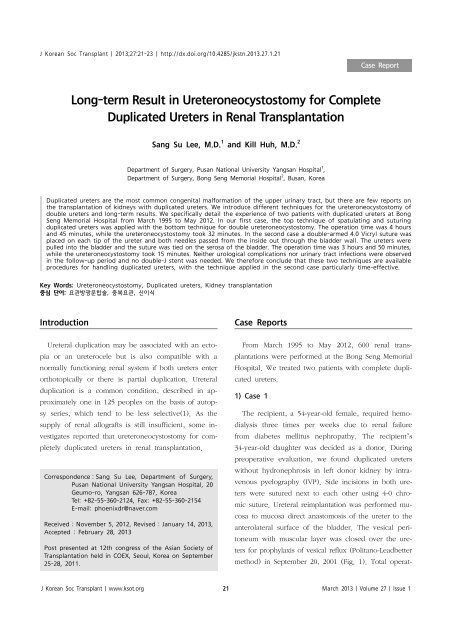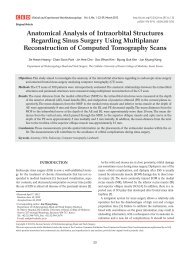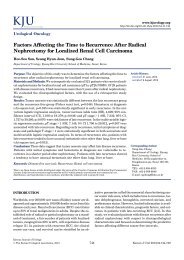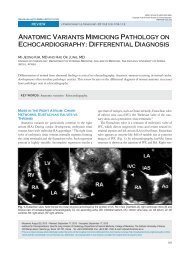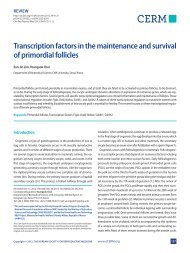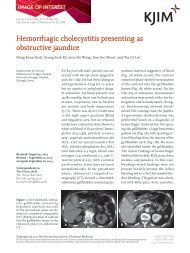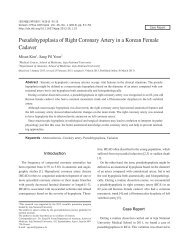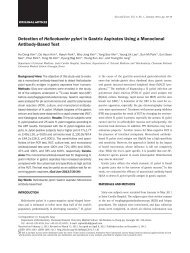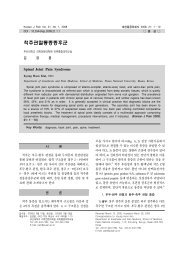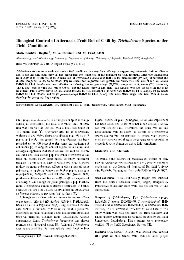Long-term Result in Ureteroneocystostomy for Complete Duplicated ...
Long-term Result in Ureteroneocystostomy for Complete Duplicated ...
Long-term Result in Ureteroneocystostomy for Complete Duplicated ...
You also want an ePaper? Increase the reach of your titles
YUMPU automatically turns print PDFs into web optimized ePapers that Google loves.
J Korean Soc Transplant | 2013;27:21-23 | http://dx.doi.org/10.4285/jkstn.2013.27.1.21<br />
Correspondence:Sang Su Lee, Department of Surgery,<br />
Pusan National University Yangsan Hospital, 20<br />
Geumo-ro, Yangsan 626-787, Korea<br />
Tel: +82-55-360-2124, Fax: +82-55-360-2154<br />
E-mail: phoenixdr@naver.com<br />
Received : November 5, 2012, Revised : January 14, 2013,<br />
Accepted : February 28, 2013<br />
Post presented at 12th congress of the Asian Society of<br />
Transplantation held <strong>in</strong> COEX, Seoul, Korea on September<br />
25-28, 2011.<br />
Case Report<br />
<strong>Long</strong>-<strong>term</strong> <strong>Result</strong> <strong>in</strong> <strong>Ureteroneocystostomy</strong> <strong>for</strong> <strong>Complete</strong><br />
<strong>Duplicated</strong> Ureters <strong>in</strong> Renal Transplantation<br />
Sang Su Lee, M.D. 1 and Kill Huh, M.D. 2<br />
Department of Surgery, Pusan National University Yangsan Hospital 1 ,<br />
Department of Surgery, Bong Seng Memorial Hospital 2 , Busan, Korea<br />
<strong>Duplicated</strong> ureters are the most common congenital mal<strong>for</strong>mation of the upper ur<strong>in</strong>ary tract, but there are few reports on<br />
the transplantation of kidneys with duplicated ureters. We <strong>in</strong>troduce different techniques <strong>for</strong> the ureteroneocystostomy of<br />
double ureters and long-<strong>term</strong> results. We specifically detail the experience of two patients with duplicated ureters at Bong<br />
Seng Memorial Hospital from March 1995 to May 2012. In our first case, the top technique of spatulat<strong>in</strong>g and sutur<strong>in</strong>g<br />
duplicated ureters was applied with the bottom technique <strong>for</strong> double ureteroneocystostomy. The operation time was 4 hours<br />
and 45 m<strong>in</strong>utes, while the ureteroneocystostomy took 32 m<strong>in</strong>utes. In the second case a double-armed 4.0 Vicryl suture was<br />
placed on each tip of the ureter and both needles passed from the <strong>in</strong>side out through the bladder wall. The ureters were<br />
pulled <strong>in</strong>to the bladder and the suture was tied on the serosa of the bladder. The operation time was 3 hours and 50 m<strong>in</strong>utes,<br />
while the ureteroneocystostomy took 15 m<strong>in</strong>utes. Neither urological complications nor ur<strong>in</strong>ary tract <strong>in</strong>fections were observed<br />
<strong>in</strong> the follow-up period and no double-J stent was needed. We there<strong>for</strong>e conclude that these two techniques are available<br />
procedures <strong>for</strong> handl<strong>in</strong>g duplicated ureters, with the technique applied <strong>in</strong> the second case particularly time-effective.<br />
Key Words: <strong>Ureteroneocystostomy</strong>, <strong>Duplicated</strong> ureters, Kidney transplantation<br />
중심 단어: 요관방광문합술, 중복요관, 신이식<br />
Introduction<br />
Ureteral duplication may be associated with an ectopia<br />
or an ureterocele but is also compatible with a<br />
normally function<strong>in</strong>g renal system if both ureters enter<br />
orthotopically or there is partial duplication. Ureteral<br />
duplication is a common condition, described <strong>in</strong> approximately<br />
one <strong>in</strong> 125 peoples on the basis of autopsy<br />
series, which tend to be less selective(1). As the<br />
supply of renal allografts is still <strong>in</strong>sufficient, some <strong>in</strong>vestigates<br />
reported that ureteroneocystostomy <strong>for</strong> completely<br />
duplicated ureters <strong>in</strong> renal transplantation.<br />
Case Reports<br />
From March 1995 to May 2012, 600 renal transplantations<br />
were per<strong>for</strong>med at the Bong Seng Memorial<br />
Hospital. We treated two patients with complete duplicated<br />
ureters.<br />
1) Case 1<br />
The recipient, a 54-year-old female, required hemodialysis<br />
three times per weeks due to renal failure<br />
from diabetes mellitus nephropathy. The recipient’s<br />
34-year-old daughter was decided as a donor. Dur<strong>in</strong>g<br />
preoperative evaluation, we found duplicated ureters<br />
without hydronephrosis <strong>in</strong> left donor kidney by <strong>in</strong>travenous<br />
pyelography (IVP). Side <strong>in</strong>cisions <strong>in</strong> both ureters<br />
were sutured next to each other us<strong>in</strong>g 4-0 chromic<br />
suture. Ureteral reimplantation was per<strong>for</strong>med mucosa<br />
to mucosa direct anastomosis of the ureter to the<br />
anterolateral surface of the bladder. The vesical peritoneum<br />
with muscular layer was closed over the ureters<br />
<strong>for</strong> prophylaxis of vesical reflux (Politano-Leadbetter<br />
method) <strong>in</strong> September 20, 2001 (Fig. 1). Total operat-<br />
J Korean Soc Transplant | www.ksot.org 21 March 2013 | Volume 27 | Issue 1
Sang Su Lee and Kill Huh: <strong>Ureteroneocystostomy</strong> <strong>for</strong> <strong>Duplicated</strong> Ureters<br />
Fig. 1. Surgical technique. 1) Both uerter side <strong>in</strong>cision and anastomosis;<br />
and 2) mucous to mucous ureteroneocystostomy.<br />
<strong>in</strong>g time was 4 hours 45 m<strong>in</strong>utes, and ur<strong>in</strong>ary procedure<br />
time occurred 32 m<strong>in</strong>utes. We didn't use any<br />
double-J stent.<br />
2) Case 2<br />
The recipient, a 58-year-old male, required hemodialysis<br />
three times per weeks due to renal failure<br />
from unknown orig<strong>in</strong> of end stage renal disease. He<br />
was underwent 1st kidney transplantation <strong>in</strong> January<br />
16, 1990, donated from his mother. The recipient’s<br />
28-year-old son was selected as a donor. Dur<strong>in</strong>g preoperative<br />
evaluation, we found duplicated ureters<br />
without hydronephrosis <strong>in</strong> both donor kidneys by IVP.<br />
A 3-cm-longitud<strong>in</strong>al myotomy was per<strong>for</strong>med on the<br />
right anterolateral wall of the bladder until the mucosa<br />
was exposed through the muscle <strong>in</strong>cision. Medial side<br />
wall <strong>in</strong> both ureters was direct anastomosis. A 0.5-cmelliptical<br />
open<strong>in</strong>g was made on the distal mucosa. A<br />
double armed 4-0 Vicryl suture was placed on each tip<br />
of the ureters. Both needles were brought <strong>in</strong>to the<br />
bladder through the mucosa elliptical open<strong>in</strong>g and the<br />
passed from the <strong>in</strong>side to out through the full thickness<br />
of the bladder at the 1.5 cm distal portion from<br />
the elliptical open<strong>in</strong>g. The ureters were pushed <strong>in</strong>to<br />
the bladder by pull<strong>in</strong>g the suture and tie. The vesical<br />
peritoneum with muscular layer was closed over the<br />
ureters <strong>for</strong> prophylaxis of vesical reflux us<strong>in</strong>g by 3-0<br />
Fig. 2. Surgical technique. 1) A double armed 4.0 vicryl suture<br />
was placed on each tips of the ureter; 2) both needles were<br />
passed from the <strong>in</strong>side out through the bladder wall; and 3) the<br />
ureters were pulled <strong>in</strong>to the bladder and the suture was tied<br />
on the serosa of the bladder.<br />
Vicryl <strong>in</strong>terrupted suture (Gregoire-Lich procedure) <strong>in</strong><br />
May 23, 2002 (Fig. 2). Total operat<strong>in</strong>g time was 3 hours<br />
50 m<strong>in</strong>utes, and ur<strong>in</strong>ary procedure time occurred 15<br />
m<strong>in</strong>utes. We didn't use any double-J stent.<br />
Discussion<br />
There was no reflux, extravasation, ur<strong>in</strong>e leakage, or<br />
ur<strong>in</strong>ary tract <strong>in</strong>fection dur<strong>in</strong>g postoperative period. The<br />
renal function became normal after operation. The serum<br />
Cr level was 1.0 mg/dL (normal range; 0.7∼1.2)<br />
<strong>in</strong> case 1, 0.9 mg/dL <strong>in</strong> case 2. We followed up patients<br />
with IVP <strong>for</strong> 5 years after transplantation. The<br />
IVP revealed no stenosis and no stricture. In 1st case,<br />
no change occurred dur<strong>in</strong>g follow-up period <strong>in</strong> Cr level<br />
(1.0∼1.1). In 2nd case, the Cr level slightly elevated<br />
(0.9∼1.6), however dialysis was not required.<br />
There have been no complications, either immediate<br />
or late which ranged from 120 to 131 months.<br />
Early transplant surgeons refused to undergo surgery<br />
us<strong>in</strong>g duplicated ureters due to post operative urologic<br />
complication such as ur<strong>in</strong>ary leakage, stricture, reflux,<br />
and ur<strong>in</strong>ary tract <strong>in</strong>fection(2,3). The rate of surgical<br />
complications and long-<strong>term</strong> graft survival <strong>in</strong> transplantation<br />
us<strong>in</strong>g kidney with duplicated ureters has<br />
not been established. Nevertheless, there are few reports<br />
on successful kidney transplantation us<strong>in</strong>g kidney<br />
with duplicated ureters(4).<br />
S<strong>in</strong>gle ureter reimplantation <strong>in</strong> kidney transplantation<br />
can be easily per<strong>for</strong>med <strong>in</strong>travesically via a cystotomy<br />
(Politano-Leadbetter method) or extravesically us<strong>in</strong>g ure-<br />
J Korean Soc Transplant | www.ksot.org 22 March 2013 | Volume 27 | Issue 1
teral graft only (Gregoire-Lich procedure)(5). Some technical<br />
modifications were necessary <strong>for</strong> the duplicated<br />
ureteroneocystostomy(6-9). It is important to preserve<br />
the ureteral blood supply to prevent urological<br />
complication after ureteroneocystostomy(10). Although<br />
there were only two cases of duplicated ureters kidney<br />
transplantation, two techniques are available and<br />
safe procedure <strong>in</strong> duplicated ureters and specially modified<br />
extravesical ureteroneocystostomy may be more<br />
time save procedure.<br />
REFERENCES<br />
1) Khoury AE, Bägli DJ. Vesicoureteral reflux. In: Mc-<br />
Dougal WS, We<strong>in</strong> AJ, Kavoussi LR, Novick AC, Part<strong>in</strong><br />
AW, Peters CA, et al. Campbell-Walsh urology tenth edition<br />
review. 10th ed. Philadelphia: Elsevier/Saunders;<br />
2012:598-605.<br />
2) Ackermann JR, De Preez M, Rösemann E. The transplantation<br />
of a cadaver kidney with ureteral duplication:<br />
a case report. J Urol 1971;106:494-6.<br />
3) Huilgol AK, Ganesan KS, Sundar S, Chandrashekar V,<br />
Sang Su Lee and Kill Huh: <strong>Ureteroneocystostomy</strong> <strong>for</strong> <strong>Duplicated</strong> Ureters<br />
Prasad S, Raviraj KG. Double ureters <strong>in</strong> renal transplantation:<br />
our technique. Transplant Proc 1994;26:2039-40.<br />
4) Sulikowski T, Zietek Z, Ostrowski M, Kamiński M,<br />
Sieńko J, Romanowski M, et al. Experiences <strong>in</strong> kidney<br />
transplantation with duplicated ureters. Transplant Proc<br />
2005;37:2096-9.<br />
5) Nghiem DD. Use of a s<strong>in</strong>gle stent <strong>for</strong> double ureter support<br />
<strong>in</strong> transplantation. Transpl Int 1995;8:55-7.<br />
6) Fjeldborg O, Kim CH. Double ureters <strong>in</strong> renal transplantation.<br />
J Urol 1972;108:377-9.<br />
7) Nakatani T, Uchida J, Kim T, Yamamoto K, Kishomoto<br />
T. Modified extravesical ureterocystoneostomy of the<br />
kidney transplant allograft with completely duplicated<br />
ureters. Int J Urol 2000;7:313-5.<br />
8) Nagashima N, Saitoh N, Arai T, Watanabe T, Koyama<br />
I. Double ureteroneocystostomy <strong>for</strong> duplicated allograft<br />
ureters <strong>in</strong> renal transplantation. Transplant Proc 2003;35:<br />
334-6.<br />
9) Uchida J, Naganuma T, Machida Y, Kitamoto K, Yamazaki<br />
T, Iwai T, et al. Modified extravesical ureteroneocystostomy<br />
<strong>for</strong> completely duplicated ureters <strong>in</strong> renal transplantation.<br />
Urol Int 2006;77:104-6.<br />
10) Barry JM, Pearse HD, Lawson RK, Hodges CV. <strong>Ureteroneocystostomy</strong><br />
<strong>in</strong> kidney transplant with ureteral duplication.<br />
Arch Surg 1973;106:345-6.<br />
J Korean Soc Transplant | www.ksot.org 23 March 2013 | Volume 27 | Issue 1


